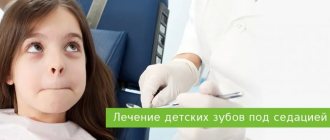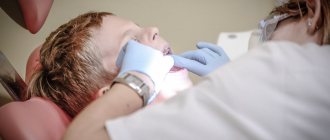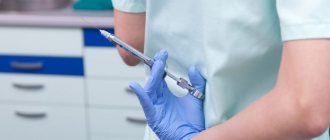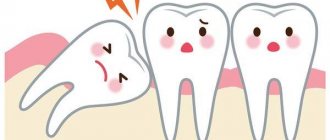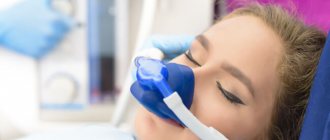Many people have heard that it is possible to perform dental treatment under general anesthesia. This practice is especially often used in pediatric dentistry, when it is necessary to carry out a large amount of dental work, and the child does not communicate well with doctors or is simply afraid. However, sometimes patients confuse the concepts of dental treatment under sedation and treatment under anesthesia - these are two completely different methods.
Pediatric anesthesia in dentistry
First, let's figure out what anesthesia is. This is a reversible inhibition of the activity of the central nervous system, which we cause artificially.
Narcosis is characterized by:
- falling asleep and decreased reflexes;
- loss of consciousness and muscle relaxation;
- complete absence of painful sensations.
Translated into simple language, this means that during general anesthesia the child falls deeply asleep, lies motionless during the procedure and does not feel anything. And after waking up he doesn’t remember anything.
They are immersed in this state using a combination of several drugs, which ensures safety and comfort for the baby. At the same time, safety comes first. Modern methods of general anesthesia completely eliminate the negative impact on the mental and physical development of a small patient.
Unlike adult dentistry, in pediatric dentistry there is no intermediate option between superficial sedation and anesthesia. This means that for children under 16 years of age there are only two options for “sleep treatment”: superficial sedation, when the child remains awake during treatment, and general anesthesia (endotracheal anesthesia). This is due to the anatomical and physiological characteristics of children. Because of them, deep intravenous sedation is impossible.
Types of combined anesthesia
- Neuroleptanelgesia. The method involves a combination of antipsychotic and narcotic drugs. In this case, antipsychotics have an inhibitory effect on the nervous system, and narcotic substances enhance the analgesic effect. The drugs most often used are: etapyrazine, aminazine, droperidol and haloperidol;
- Intubation anesthesia. The substance enters the respiratory system using a laryngeal mask. Due to its complexity, this method is also not used often.
Ataralgesia. The combination of analgesics and tranquilizers gives a calming, relaxing and analgesic effect. The most commonly used tranquilizer components are: Relanium, Elenium, Phenazepam and Grandaxin.
Should children undergo dental treatment under anesthesia when they cry?
If your baby cries at the dentist, he may just be very emotional. And then, to calm him down, kind words are enough.
An experienced doctor knows how to find a common language with children, and there are usually no difficulties with treatment. There are many adaptive techniques when the doctor explains to the child in a playful manner that treatment is interesting and not painful at all. In addition, to cope with your baby’s fear, you can use the help of a psychologist.
If these methods do not help, then you can try the procedure under sedation. It muffles fear and temporarily dulls the baby's reactions.
Tears are not a good reason to perform dental treatment under anesthesia in children. It is worth resorting to it only if other methods of “agreeing” have not been successful. Anesthesia in pediatric dentistry is used if there are indications for it.
Treatment of baby teeth under anesthesia is carried out:
- if it is impossible to establish contact with the baby;
- dental treatment for children under 3 years of age;
- allergies to local anesthesia;
- mental illnesses or nervous system disorders: schizophrenia, epilepsy, Parkinson's disease, cerebral palsy, mental retardation;
- insurmountable fear of dental treatment (scientifically called dentophobia);
- strong gag reflex, which interferes with the treatment of distant teeth;
- extensive surgical operations: complex tooth extraction, abscesses, periostitis, lymphadenitis, serious jaw injuries.
When children should not use anesthesia for dental treatment:
✔
during the acute course of the infectious process;
✔
with decompensation of severe chronic diseases.
In general, there are no absolute contraindications to general anesthesia in children. Sometimes you just need to wait for the right moment or choose the most suitable technique. If the baby has an acute situation - pain or injury - there is always the opportunity to safely and comfortably undergo treatment under anesthesia.
Everything you need to know about Sevoflurane
This is a safe drug that was synthesized back in the 70s of the last century. However, it began to be used in pediatric dentistry much later: first in Japan, and in the 1990s in the UK, USA and Western Europe. In 2004, the Russian Ministry of Health authorized the use of Sevoflurane in Russia. During the procedure, the child sleeps without feeling pain or fear, and does not hear the sound of the drilling machine. After stopping the supply, the drug is quickly eliminated from the body, leaving no discomfort.
How to prepare a child for dental treatment under anesthesia
- Before treatment, you should consult with an anesthesiologist. This can usually be done over the phone, but in some cases a face-to-face appointment is required.
To correctly administer general anesthesia, the anesthesiologist will need the following information:
- child development history;
- allergic reactions;
- past acute and chronic diseases;
- previous medical interventions and hospitalizations;
- anthropometric data (age, height, weight).
To clarify the child’s health status, you will need to undergo a series of tests. The anesthesiologist determines the full scope of the required examination based on the characteristics of the small patient and the type of upcoming treatment.
- Before anesthesia, diet is very important. The safety of anesthesia depends on its compliance.
The child who will best tolerate anesthesia is the one who:
- did not eat “heavy food” during the 6 hours preceding treatment;
- 4 hours before the procedure I had a snack;
- I drank water 2 hours before.
Dietary recommendations may vary, so the final meal plan will be discussed in consultation with the anesthesiologist.
- To help parents not be nervous, I also recommend asking the anesthesiologist what his qualifications are and what equipment he will use during the procedure. You definitely shouldn’t be embarrassed about such questions. Doctors with experience in pediatric anesthesiology should work with children, since the structure of the child’s body and its functioning have their own characteristics.
Dental anesthesia for children: indications
General anesthesia in dentistry is prescribed to children in different cases:
- Panic fear of doctors, psychological reactivity. Even the best dentists sometimes put children under stress. The prerequisites are different - bad experience, peculiarities of the nervous system, dental phobia. Holding a patient by force and physically forcing him to treat his teeth is inhumane and only worsens the situation. Therefore, for anxious and fearful children, dental anesthesia is the best choice.
- A lot of work. In advanced dental cases, many units need treatment. In a state of medicated sleep, everything can be cured at the same time with minimal stress on the child.
- Difficult removal of teeth or tumors. Large surgical procedures are recommended to be performed under general anesthesia - painlessly and unnoticed by the patient.
- The impossibility of using another anesthesia option and standard treatment option is due to allergic reactions and a pronounced gag reflex.
- Neurological and psychiatric diagnoses. General anesthesia in dentistry is recommended for children with cerebral palsy, epilepsy, and Down syndrome.
The decision on medicinal sleep and treatment under a mask is made by doctors after a complete diagnosis of the oral cavity and assessment of associated factors.
How is dental treatment performed for children under anesthesia?
During treatment under general anesthesia, the child does not feel anything. And he doesn’t remember anything after waking up. This is achieved by a combination of drugs. The main one among them is Sevoran.
The combination of drugs and their doses are calculated individually for each child. In this case, the doctor takes into account the age, weight and characteristics of the small patient. The use of combinations of anesthetics makes it possible to minimize their doses and carry out a high-quality and safe procedure.
The child falls asleep after a few breaths through the mask of the anesthesia machine. This happens in the arms of the mother. We perform induction of anesthesia as comfortably as possible for the baby. If a child comes with his favorite toy, we show her by example: inhalation from a mask is not scary.
In cases where parents warn the anesthesiologist that even a mask causes negative emotions in the child, premedication can be used. Then we administer a mild sleeping pill to the baby in the form of nasal drops, after which the child plays or watches cartoons for 30-40 minutes and gradually falls asleep in his mother’s arms. And then we begin induction of anesthesia.
An anesthesiologist and a nurse anesthetist are responsible for administering general anesthesia. Their interaction ensures the safety of the child. The baby is under constant control, precisely calculated doses of drugs are administered at the appropriate time. It takes approximately 30 minutes in addition to the treatment time for the anesthesiologist to induce anesthesia and wake up.
Introduction of anesthesia: step-by-step description
- Introduction to a state of anesthesia.
- Analgesia. The duration of the stage is approximately 4-5 minutes. At this time, the patient's pain sensitivity decreases, but all reflexes and stable body temperature are preserved.
- Excitation. The duration of the stage is 7 minutes. During this period, the following are observed: instability of pulse and temperature, increased salivation and muscle tone.
- Maintaining anesthesia. This stage is conditionally divided into several stages-levels:
- Surface. The following are noted: normalization of pulse and pressure, muscle tone with complete blocking of sensitivity;
- Easy. Characterized by rhythmic breathing and muscle relaxation. At this point, the doctor can already begin initial, superficial manipulations;
- Full anesthesia. There is complete relaxation of the muscles, rhythmicity of the pulse and breathing, and a slight decrease in blood pressure;
- Ultra-deep anesthesia. Characterized by shallow breathing, weak pulse and low blood pressure.
After completing the manipulations, the supply of the anesthetic substance is stopped and it is replaced with pure oxygen for 2-3 minutes. It is during this interval that the patient awakens, and after 30 minutes his complete recovery is observed.
What is rehabilitation like after treatment under anesthesia?
After waking up from anesthesia, in the vast majority of cases, children feel well. Most often, the only thing that bothers them is numbness in the areas where the local anesthetic was injected.
As for behavioral changes, there are three types:
- excitement - the baby may be capricious and cry. This is accompanied by increased activity. But it quickly gives way to fatigue;
- fatigue - the child wants to sleep, refuses to eat, sits in the arms of the parents;
- no behavioral changes after waking up.
The first two scenarios are typical for children under the age of 7-10 years, the third - for adolescents and adults.
Hyperactivity and agitation upon awakening are unpleasant for both the child and those around him. To avoid it, we try to implement the second scenario; to do this, we put the baby to sleep and wake him up gently.
The child can eat immediately after waking up, unless the anesthesiologist gives other recommendations.
Very rarely, recovery from anesthesia is accompanied by nausea or a feeling of motion sickness. This lasts no longer than 2-3 hours. This reaction is typical for children who get motion sickness in transport. In this case, you will be able to eat and drink within an hour or after the nausea has passed.
There is no need to worry about the postoperative period - the anesthesiologist will always be in touch.
Appointment and preparation for surgery
After all the above steps are completed, the date for the operation in a dream is set.
It is important to remember that on the day of the appointment there are a number of actions that need to be completed:
- Do not eat or drink anything at all (6-7 hours before the appointed time);
- It is advisable not to smoke (if the habit is strong, 2-3 cigarettes, but no more);
- Do not drink alcohol for 48 hours;
- Take medications (if they were recommended by the anesthesiologist);
- The uniform should be loose, in no way constrictive and easy to unfasten (no elastic bands, complex locks, etc.);
- Appoint an accompanying person who will take you home by car at the end of the operation.
Stages of sedation
- Easy
. The patient is in a state of relaxation, but is awake and makes contact with the doctor. Although his reactions and coordination are slightly reduced. This type of sedation is also called superficial. - Average
. A state of consciousness in which patients respond to tactile stimuli, all functions are preserved, reflexes work, and there is interaction with the doctor. - Deep
. The patient reacts only to strong stimulation; the patient does not respond to a call, but the cardiovascular system works normally. Breathing may become irregular
The next stage is complete anesthesia. With it, there is no reaction even to strong painful stimuli. Respiratory support is often needed.
TO TREAT OR TO SUFFER?
“Can the child be patient? After all, anesthesia is harmful...” is the most common question from parents at an appointment with our pediatric dentists.
Sometimes you can do without anesthesia, but in some situations, treatment without it is a case where the harm outweighs the benefit
It is very important for us that the child does not experience stress when visiting the dentist, so we are against treatment with retention and treatment without pain relief.
Even if the child endures treatment without anesthesia and endures pain, the next time he will be afraid to go to the doctor, and he may even try to hide from his parents that he is in pain.
The decision on the need to use anesthesia, anesthesia or sedation must be made by the doctor, based on the specific case. Sometimes anesthesia can be abandoned, for example, if only the top layer of enamel is susceptible to caries; when sealing fissures, professional hygiene and fluoridation, anesthesia is not required
Anesthesia or anesthesia?
First of all, let's define the terminology. In medicine there is no concept of “local anesthesia”. There is anesthesia (that is, general by default), as well as local anesthesia. The second method is traditionally used to relieve pain in most dental procedures, from treating caries to removing advanced dental plaque. As for anesthesia, it is used in cases where the patient has a low pain threshold or experiences an uncontrollable panic fear of the dentist’s chair. It cannot be avoided even with more serious interventions (sinus lifting or bone grafting, surgery of maxillofacial injuries).
